Abstract
In the large amoeboid organism Physarum, biochemical oscillators are spatially distributed throughout the organism and their collective motion exhibits phase waves, which carry physiological signals. The basic nature of this wave behaviour is not well-understood because, to date, an important effect has been neglected, namely, the shuttle streaming of protoplasm which accompanies the biochemical rhythms. Here we study the effects of self-consistent flow on the wave behaviour of oscillatory reaction-diffusion models proposed for the Physarum plasmodium, by means of numerical simulation for the dispersion relation and weakly nonlinear analysis for derivation of the phase equation. We conclude that the flow term is able to increase the speed of phase waves (similar to elongation of wave length). We compare the theoretical consequences with real waves observed in the organism and also point out the physiological roles of these effects on control mechanisms of intracellular communication.
Similar content being viewed by others
References
Aliev R.R. (1994). Oscillation phase dynamics in the Belousov–Zhabotinsky reaction—implementation to image-processing. J. Phys. Chem. 98: 3999–4002
Aliev R.R. and Biktashev V.N. (1994). Dynamics of the oscillation phase distribution in the BZ reaction. J. Phys. Chem. 98: 9676–9681
Kamiya N. (1959). Protoplasmic streaming. Protoplasmatologia 8: 1–199
Kobayashi R., Tero A. and Nakagaki T. (2006). Mathematical model for rhythmic amoeboid movement in the true slime mold. J. Math. Biol. 53: 273–286
Kuramoto Y. and Tsuzuki T. (1975). Formation of dissipative structures in reaction-diffusion systems—reductive perturbation approach. Prog. Theor. Phys. 54: 687–699
Kuramoto Y. and Yamada T. (1976). Pattern formation in oscillatory chemical-reactions. Prog. Theor. Phys. 56: 724–740
Matsumoto K., Ueda T. and Kobatake Y. (1988). Reversal of thermotaxis with oscillatory stimulation in the plasmodium of Physarum polycephalum. J. Theor. Biol. 131: 175–182
Miyake Y., Tabata S., Murakami H., Yano M. and Shimizu H. (1996). Environment-dependent self-organization of positional information field in chemotaxis of Physarum polycephalum. J. Theor. Biol. 178: 341–353
Murray J.D. (1989). Mathematical Biology. Springer, Heidelberg
Nakagaki T., Yamada H. and Masami I. (1999). Reaction-diffusion-advection model for pattern formation of rhythmic contraction in a giant amoeboid cell of the Physarum plasmodium. J. Theor. Biol. 197: 497–506
Nakagaki T., Yamada H. and Ueda T. (1999). Modulation of cellular rhythm and photoavoidance by oscillatory irradiation in the Physarum plasmodium. Biophys. Chem. 82: 23–28
Nakagaki T., Yamada H. and Ueda T. (2000). Interaction between cell shape and contraction pattern in the Physarum plasmodium. Biophys. Chem. 84: 195–204
Nakamura S., Yoshimoto Y. and Kamiya N. (1982). Oscillation in surface pH of the Physarum plasmodium. Proc. Jpn. Acad. 58: 270–273
Ortoleva P. and Ross J. (1973). Phase waves in oscillatory chemical reactions. J. Chem. Phys. 58: 5673–5680
Ortoleva P. and Ross J. (1974). On a variety of wave phenomena in chemical-reactions. J. Chem. Phys. 60: 5090–5107
Ortoleva P. (1976). Local phase and renormalized frequency in inhomogeneous chemioscillations. J. Chem. Phys. 64: 1395–1406
Polezhaev A.A. (1995). Phase waves in oscillatory media. Physica D 84: 253–259
Schnackenberg J. (1979). Simple chemical-reaction systems with limit cycle behavior. J. Theor. Biol. 81: 389–400
Tero, A., Kobayashi, R., Nakagaki, T., Physica, D.: A coupled-oscillator model with a conservation law for the rhythmic amreboid movements of plasmodial slime moulds, vol. 205, 125–135 (2005)
Ueda, T.: Intracellular oscillations and pattern formation in the cell behavior of Physarum. In: Rensing, L., (ed.) Oscillations and morphogenesis. 167-181, Marcel-Dekker, New York (1993)
Ueda T., Matsumoto K., Akitaya T. and Kobatake Y. (1986). Spatial and temporal organization of intracellular adenosine nucleotide and cyclic nucleotides in relation to rhythmic motility in Physarum polycephalum. Exp. Cell Res. 162: 486–494
Yamada H., Nakagaki T. and Ito M. (1999). Pattern formation of a reaction-diffusion system with self-consistent flow in the amoeboid organism Physarum plasmodium. Phys. Rev. E 59: 1009–1014
Yoshimoto Y., Matsumura F. and Kamiya N. (1981). Simultaneous oscillations of Ca2+ efflux and tension generation in the permealized plasmodial strand of Physarum. Cell Motility 1: 433–443
Yoshimoto Y., Sakai T. and Kamiya N. (1981). ATP oscillation in Physarum plasmodium. Protoplasm 109: 159–168
Yoshimoto Y., Sakai T. and Kamiya N. (1984). ATP- and calcium-controlled contraction in a saponin model of Physarum polycephalum. Cell Struct. Funct. 9: 135–141
Author information
Authors and Affiliations
Corresponding author
Rights and permissions
About this article
Cite this article
Yamada, H., Nakagaki, T., Baker, R.E. et al. Dispersion relation in oscillatory reaction-diffusion systems with self-consistent flow in true slime mold. J. Math. Biol. 54, 745–760 (2007). https://doi.org/10.1007/s00285-006-0067-1
Received:
Revised:
Published:
Issue Date:
DOI: https://doi.org/10.1007/s00285-006-0067-1




